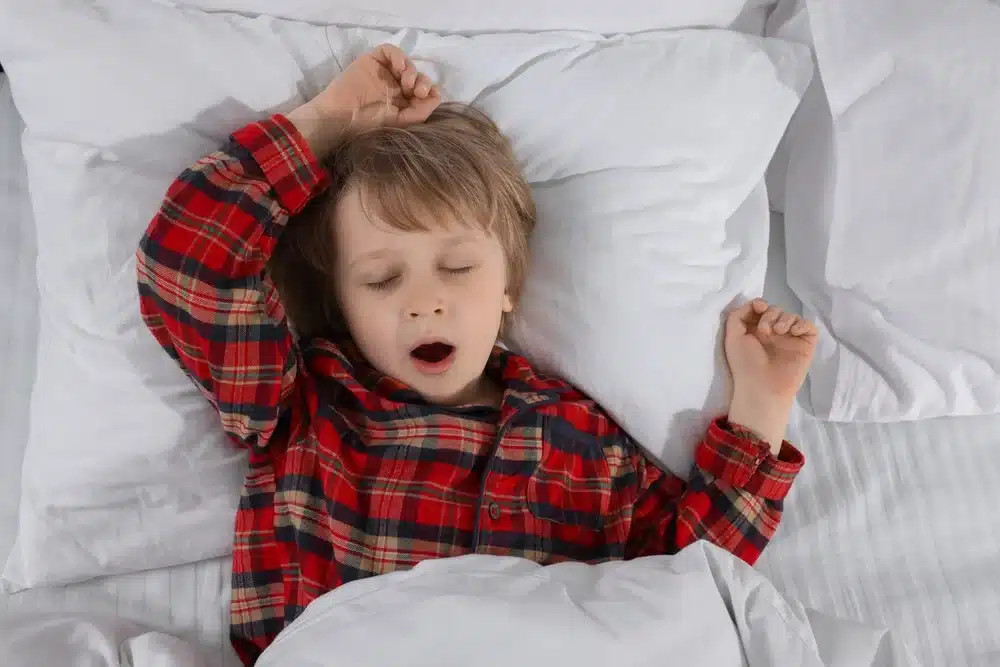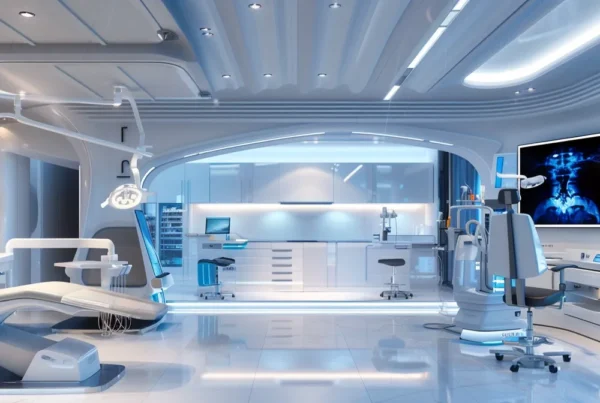Kids with sleep apnea show warning signs during both day and night that parents often miss. Watch for restless sleep, unusual sleeping positions, mouth breathing, behavioral changes, school struggles, and morning headaches. Dr. Eugene Azuma has spent over 30 years helping Honolulu families identify these hidden symptoms before they cause lasting harm to growth, learning, and emotional development.
Your child tosses and turns all night but you think they’re just restless. They struggle in school but you assume they need more discipline. Dr. Eugene Azuma has evaluated countless Honolulu children whose parents never suspected sleep apnea. After establishing his practice in 1990 and becoming a specialist in dental sleep medicine, Dr. Azuma learned that the most dangerous symptoms are often the ones parents miss completely.
Sleep apnea in children rarely looks like what you’d expect. Kids don’t typically complain about being tired or having trouble breathing. Instead, they become moody, hyperactive, or fall behind at school. Recognizing these hidden signs helps you catch problems before they cause lasting damage.
Sleep Patterns That Signal Trouble
Nighttime behaviors reveal what’s really happening with your child’s breathing. You have to know what to look for beyond simple snoring.
Unusual sleep positions tell an important story. Your child might sleep with their neck stretched back unnaturally. Some kids sleep on all fours or propped up on pillows. Your child’s body instinctively tries to open their airway.
Constant movement during sleep indicates breathing struggles. Each time breathing becomes difficult, your child’s body shifts position. The sheets get twisted and blankets end up on the floor. This restless pattern prevents deep, restorative sleep.
Breathing pauses are the most concerning sign. You might notice your child stops breathing for several seconds. Then they gasp or choke before breathing resumes. Each pause disrupts sleep quality and reduces oxygen to the brain.
Daytime Behaviors Nobody Connects to Sleep
What happens at night doesn’t stay at night. Sleep apnea symptoms follow your child through their entire day.
Irritability and emotional outbursts stem from exhausted brains. Your previously calm child becomes difficult to manage. Small frustrations trigger big reactions. The real issue is brain chemistry thrown off by poor sleep quality.
School performance drops when sleep quality suffers. Your child might have trouble focusing on lessons. Memory problems make learning new material difficult. But the truth is their brain can’t function properly without quality rest.
Here’s what daytime sleep apnea symptoms look like in children:
- Uncharacteristic irritability that seems out of proportion
- Attention difficulties in school and during homework
- Academic decline despite adequate intelligence
- Hyperactivity that masks underlying exhaustion
- Emotional instability with frequent mood swings
- Social problems with peers and siblings
- Morning headaches that fade as the day progresses
- Chronic fatigue despite spending enough time in bed
The ADHD overlap confuses many families. Hyperactivity, inattention, and impulsiveness look identical to ADHD. Some children get misdiagnosed and put on medication they don’t need. While this information helps you understand potential connections, only qualified medical professionals can diagnose and recommend appropriate treatment for your child’s specific situation.
Physical Signs You Might Miss
Some sleep apnea symptoms show up during the day in ways that seem unrelated. These physical signs deserve your attention.
Mouth breathing indicates blocked nasal airways. You notice your child always has their mouth open. This constant mouth breathing can actually change how the face develops over time. It affects jaw growth and tooth positioning.
Morning headaches signal oxygen deprivation during sleep. Your child wakes up with their head hurting. The pain usually fades within an hour or two. These headaches happen because the brain didn’t get adequate oxygen overnight.
Slower growth rates sometimes connect to sleep problems. Growth hormone releases during deep sleep stages. When sleep apnea prevents deep sleep, growth hormone production drops. Your pediatrician might notice your child falling off their growth curve.
These warning signs often get overlooked as unrelated issues. Paying attention to these patterns helps catch sleep apnea early.
Children at Higher Risk
Some kids face greater likelihood of developing sleep apnea. Understanding risk factors helps you stay vigilant.
| Risk Factor | How It Increases Risk | What Parents Should Do |
| Enlarged Tonsils/Adenoids | Physically blocks the airway | Request throat exam at checkups |
| Family History | Genetic predisposition to narrow airways | Inform doctors about family sleep apnea |
| Neuromuscular Conditions | Weakens respiratory muscles | Schedule regular sleep assessments |
| Obesity | Extra tissue narrows airways | Focus on healthy weight with medical guidance |
| Craniofacial Differences | Affects airway size and shape | Seek evaluation from airway specialist |
Enlarged tonsils and adenoids are common culprits in Honolulu children. The tissue physically blocks the airway during sleep. Kids who get frequent throat infections or strep throat face higher risk. Regular throat examinations during dental visits can catch this early.
Family history matters more than most parents realize. If parents or siblings have sleep apnea, children carry increased risk. Narrow airways and certain facial structures run in families. This genetic connection makes screening even more important for at-risk children.

When Misdiagnosis Causes Real Harm
Getting the wrong diagnosis delays proper treatment and allows damage to continue. Understanding these risks motivates parents to push for complete evaluations.
Physical development suffers from untreated sleep apnea. Growth hormone disruption affects height and weight gain. The immune system weakens, making infections more frequent. Cardiovascular health takes a hit from repeated oxygen drops.
Cognitive development gets derailed by poor sleep. Learning becomes harder as memory formation suffers. Your child might get labeled with learning disabilities when the real issue is sleep-deprived brain function. This misidentification leads to wrong interventions that don’t address the actual problem.
Emotional stability crumbles under chronic fatigue. Mood swings, anxiety, and depression symptoms can all stem from disrupted sleep. Treatment focuses on behavior modification when fixing the sleep problem would resolve everything. Early diagnosis prevents years of unnecessary struggle and misguided treatments.
How Parents Make the Biggest Difference
Your observations and actions directly impact whether your child gets diagnosed properly. Parents are the first line of defense.
Detailed documentation helps medical professionals understand the full picture. Keep a sleep log noting snoring patterns, breathing pauses, and unusual positions. Record daytime behaviors like irritability or attention problems. Video your child sleeping to show doctors exactly what happens.
Pushing for thorough evaluation prevents dismissal of symptoms. Some doctors minimize concerns about snoring or behavior changes. Don’t accept reassurances that your child will outgrow it. Your persistence gets your child the care they need.
Following through with treatment helps achieve success. Whether it’s using oral appliances, making lifestyle changes, or preparing for surgery, your commitment matters. Your ongoing involvement protects your child’s health long-term.
Getting Professional Help in Honolulu
Medical expertise guides treatment decisions for your child’s specific needs. Dr. Azuma and his team provide specialized evaluation and care.
As Vice President of the American Sleep and Breathing Academy and a certified diplomate, Dr. Azuma stays current with treatment approaches. His 30-plus years of dental experience combined with sleep medicine expertise benefits Honolulu families across Oahu neighborhoods from Kailua to Kapolei. Treatment options get customized to each child’s needs. CPAP therapy works for some children while dental appliances help others.
Educational support helps children succeed despite challenges. School personnel who understand sleep apnea can make appropriate accommodations. This support keeps children engaged in learning while addressing health issues. Community resources and support groups connect families facing similar challenges.
Prevention Starts with Awareness
Taking proactive steps reduces sleep apnea risk. Smart prevention protects your child’s health from the start.
Monitoring physical development catches problems early. Watch for enlarged tonsils during illness. Notice if nasal breathing seems difficult. Track growth patterns on pediatric charts.
Understanding hereditary factors increases vigilance. If sleep apnea runs in your family, watch your children more carefully. Discuss family history with healthcare providers. Early awareness leads to early intervention when needed.
Creating healthy sleep environments supports quality rest. Keep bedrooms cool, dark, and quiet. Establish consistent bedtimes and routines. These habits optimize the sleep your child can achieve and make problems more noticeable.
Protecting Your Child’s Health and Future
Hidden symptoms make pediatric sleep apnea dangerous. What you don’t see can still cause serious harm to your child’s development.
Dr. Eugene Azuma brings specialized expertise in dental sleep medicine to every patient evaluation. His education from Georgetown University, decades of practice experience, and leadership role in the American Sleep and Breathing Academy help Honolulu families receive comprehensive care. His practice combines advanced diagnostic tools with personalized treatment approaches.
Trust your observations and instincts when something seems wrong with your child’s sleep. Professional evaluation provides answers and solutions. Contact Dr. Azuma’s practice today to schedule a comprehensive airway assessment. Your child’s healthier, happier future starts with recognizing the signs and taking action now.
Azuma Dental
Dr. Eugene Azuma
1580 Makaloa Street #950
Honolulu, HI 96814
(808) 955-6677
Frequently Asked Questions
What are the typical signs of sleep apnea in children?
Loud snoring that happens most nights is the most common sign. Watch for restless sleep with frequent position changes. Breathing pauses or gasping during sleep need immediate attention. Daytime signs include hyperactivity, attention problems, and behavioral changes. Morning headaches and chronic fatigue despite adequate sleep time also signal problems.
Can pediatric sleep apnea affect my child’s growth and learning?
Sleep apnea seriously impacts both growth and learning. Growth hormone releases during deep sleep stages that get disrupted by breathing problems. This affects height and weight gain. Learning suffers because memory consolidation happens during sleep. Your child might struggle with focus, retention, and academic performance. Early treatment prevents these developmental problems from compounding.
What should I do if I suspect my child has sleep apnea?
Start by documenting what you observe during sleep and throughout the day. Keep notes about snoring patterns, breathing pauses, and behavioral changes. Video record your child sleeping if possible. Then schedule an appointment with a sleep specialist like Dr. Azuma. He’ll perform a comprehensive evaluation of your child’s airway and breathing patterns. A sleep study might be recommended to confirm diagnosis and guide treatment decisions.



